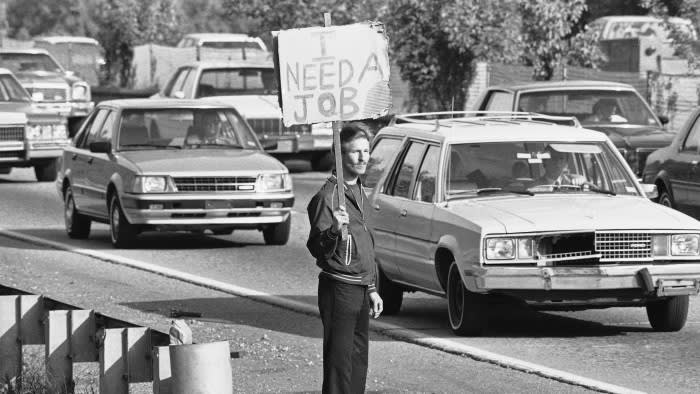Unlock the Editor’s Digest for free
Roula Khalaf, Editor of the FT, selects her favourite stories in this weekly newsletter.
There isn’t much that economists agree on, but it’s hard to find one who doesn’t believe the old investor adage that the phrase “this time is different” is one of the most dangerous in markets.
So why is it that a mention of the recent behaviour of one particular market phenomenon and its famed power to predict recession is almost always met with a response of “yes but”?
The indicator is known as the inversion of the yield curve — the line plotted between US Treasury bond yields on different maturities, most usually between two- and 10-year issues. It normally slopes upward to reflect the higher risk of lending for longer. When it inverts — that is, flips direction so longer-term yields are lower — it implies expectations that rates will fall to stimulate growth.
To some, the mere fact that it costs Washington less per year to borrow for 10 years than for two is a portent that something is simply wrong — investors are accepting lower returns for taking on more risk over time. To others, the inverted curve itself slows the economy, with banks less likely to lend long when they earn less.
Before each of the six US recessions since 1980 began, the curve inverted. For the four of those since 1990, the inversion switched back to a normal shape just before the recession hit, often because short-dated yields were falling in anticipation of interest rate cuts.
After two-plus years of inversion, yields on two-year notes slipped below those on 10-year bonds two weeks ago. Yet this week the S&P 500 hit a fresh record after the Federal Reserve began cutting rates to help keep the economy in what chair Jay Powell said was “a good place”.
Could it really be different this time? Yield curve believers don’t think so. They often start by pointing to human psychology. Wall Street sells investing dreams and no one likes to be the first to bring up the R-word.
“I’ve been fired twice for forecasting recessions. The fact that I was correct had nothing to do with it,” says economist Gary Shilling, who believes in the yield curve’s signal but cautions that its movements don’t indicate how severe any downturn might be.
There’s also the fact that a roaring stock market and warnings from bond yields often coexist. In 2000, inversion began more than a month before the Nasdaq peaked in March of that year and ended three months before the recession began in March 2001, according to the National Bureau of Economic Research, the arbiter of American economic cycles. In 2006, the S&P 500 had about 20 per cent of rally to go when the curve began to flip direction in June. Stocks only peaked in October 2007 — four months after yields normalised and two before recession began.
“Most economists only started calling a recession in September of 2008, not understanding that it was not the financial crisis that caused it — it was the Fed and the crisis exacerbated it,” says David Rosenberg of Rosenberg Research. Considered one of Wall Street’s bears, he backed the curve’s predictive power that time and thinks a recession is likely this time, too.
It doesn’t help that there’s little agreement over which yield curve to track. While two-year against 10-year is common, many economists prefer to start with the three-month Treasury bill. Powell himself made a case for a looking at a curve covering just 18 months in a 2022 speech.
Goldman Sachs’ investment strategy group, which advises its richest clients, tracks four different curves, all of which have now inverted, and it still doesn’t have a recession as its base case. “The key question is, is the dis-inverting because the Fed is likely to engineer a soft landing or is it just because the Fed is behind the curve?” asks Goldman’s Brett Nelson.
There’s always something that makes this time feel different. In 2000, the tech boom was changing the economy. In 2006, Chinese and Japanese buying of long-term bonds was holding down long-term yields. This time, reasons include the severity of pandemic-induced inflation.
“History casts a long shadow. Ironically here the problem is folks keep thinking about the historical shadow of the inverted curve rather than attending to the short-term dynamics,” says Fred Carstensen, an economic historian at the University of Connecticut.
Even as the economists debate though, investors must put their funds to work and hope not to get caught out too badly, whichever side is right. “The recession has been delayed, but no, we don’t think it’ll be avoided,” says Bryan Whalen, chief investment officer at asset manager TCW. “If we’re wrong and we do have a soft landing, there’s not a lot of upside — credit spreads are tight. If we’re right, that’s a big windfall in our favour. Those are good odds.”
https://www.ft.com/content/e73831d9-1fdc-407d-ba34-fe46f4db2564



